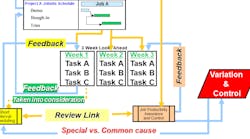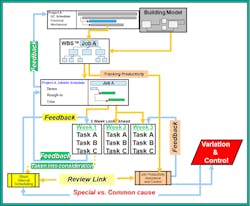As with any job site, the main crux of issues usually revolves around the general contractor (GC) schedule or lack thereof. An overall project schedule is usually produced prior to the job starting and passed on to all the respective trades, who then plan their work accordingly.
As the project progresses, impacts and issues start popping up on a weekly or even daily basis. Areas are not ready as scheduled, your team is constantly working on top of another crew, or they can’t complete their work due to waiting on another trade. Sound familiar? How does your company handle schedule changes on job sites? Do you delegate certain people to handle them accordingly, or is it up to the foreman and crew to fend for themselves?
Take a few minutes to read through the following simple questions that pertain to project schedules as a whole (they are not trick questions), and see how they apply to your current project or one you have been involved with in the past.
When do you find out that the GC's schedule has changed?
- When they tell you
- When the other trades can’t finish their work on time
- When the owner wants to issue change orders
- When the architect changes the plans and drawings
- When the engineers change their specs
- When the weather impacts the job
Who from your company is the first to know that the schedule has changed?
- Your project manager
- Your general foreman
- Your foreman
- You hear it from other trades
- You hear it from the GC’s project manager
What are your options when the project schedule changes?
- Inform the GC that you need a few days to let them know the impact.
- It’s a waste of time to try to tell anyone anything.
- You have no options because you have to continue to do your work.
- Move your guys just to keep them busy somewhere else in the job.
- There isn’t anywhere else to move your guys so you just (fill in the blank)…
- You think you have unlimited time to react.
In your company or on your projects:
- Do you know who is responsible for reading the contract about the schedule change and the time to react to its impact?
- Who would know how much time you have to respond?
- Have you ever sent a letter stating that you reserve the right to respond within the next few week?
- Do you have a way to measure the impact of the schedule change?
- Do you have a way or process for reporting back to the GC to show the impacts from the schedule change?
If you were unable to apply answers to all the questions above — or continue to struggle with managing schedule changes — then you probably do not have an actual scheduling process. What if I tell you that if you don’t have a process for getting the instantaneous feedback from your jobs about the schedules, you are likely to lose 15% to 30% productivity for working on the unscheduled tasks?
To create a schedule process in your company, it is important to have a flow that starts with the GC schedule and includes steps and tools that help you to measure, respond, and manage the schedule impact on your jobs. Job-site intelligence will play a big part in creating the process flow, as is outlined in the Figure below.
Using the data gathered from your job site on a daily and weekly basis, you can set up the same exact flow shown in the Figure. Here’s how:
- Get the GC schedule (if one is available).
- Have the foreman break down work in measurable tasks (one example is MCA’s Work Breakdown Structure or WBS), using their plans, specs, and BIM model if they have one.
- Take this information and create a job-site schedule, adding in start and end dates.
- Create your three-week look ahead from your schedule. This rolls every week for the next three weeks and shows the areas and work that will be available for the crew to complete.
- Have the foreman and crew do daily task schedules using software tools that also have the option to show impacts if tasks can’t be completed.
- Use the WBS to track productivity (you can use what you have or use ASTM E2691 JPM).
- Use the feedback your electricians are giving you from productivity and scheduling tracking to identify any impacts due to schedule changes.
- Use this job-site data to update the schedule and create the next three-week look ahead.
- Take the feedback from your schedule to your GC to show the impact of their schedule change (for whatever the reason may be).
- Enjoy the extra money you make by avoiding lost productivity and controlling job-site variations.
Dr. Perry Daneshgari is president and CEO of MCA, Inc., Grand Blanc, Mich. He can be reached at [email protected].




